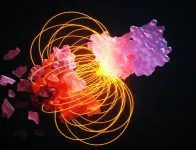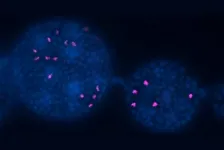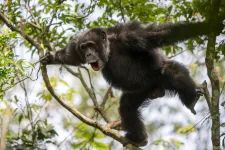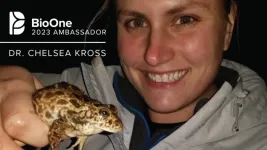(Press-News.org) In 2019, scientists in the joint School of Engineering and School of Life Sciences Laboratory of Protein Design and Immunoengineering (LPDI) led by Bruno Correia developed MaSIF: a machine learning-driven method for scanning millions of protein surfaces within minutes to analyze their structure and functional properties. The researchers’ ultimate goal was to computationally design protein interactions by finding optimal matches between molecules based on their surface chemical and geometric ‘fingerprints’.
Four years later, they have achieved just that. In a paper published in Nature, they report that they have created brand-new proteins called binders that are designed to interact with four therapeutically relevant protein targets, including the SARS-CoV-2 spike protein.
Engineering a perfect molecular match
Physical interactions between proteins influence anything from cell signaling and growth to immune responses, so the ability to control protein-protein interactions is of great interest to the fields of biology and biotechnology. While textbook depictions of protein binding may look as simple as fitting puzzle pieces together, the reality is more complex: protein surfaces vary widely and are dynamic, making it hard to predict how and where binding events will occur.
“A puzzle piece is two-dimensional, but with protein surfaces, we are looking at multiple dimensions: chemical composition, such as positive versus negative charge interactions; shape complementarity, curvature, etc.,” explains LPDI PhD student and co-author Anthony Marchand.
“The idea that everything in nature that binds is complementary – for example, a positive charge binds with a negative charge – has been a long-standing idea in the field, which we captured in our computational framework.”
To design novel protein binders, the researchers used MaSIF to create protein surface ‘fingerprints’, and then identified complementary surfaces for key protein target sites from a database of fragments. They then digitally grafted the fragments onto larger protein scaffolds, and selected the resulting binders predicted to interact best with their targets. After synthesizing and testing these selected binders in the lab, the researchers were able to confirm the computationally generated hypothesis.
“The fact that we’re able to design novel, site-specific protein binders in just a couple of months makes this method very interesting for therapeutics. It’s is not just a tool: it’s a pipeline,” Marchand says.
‘Straight from the computer’
The researchers were developing protein binders for three major cancer immunotherapy targets when the COVID pandemic hit, so they added the SARS-CoV-2 spike protein to their list. Using their approach, the four binders they produced displayed excellent affinities for their targets.
MaSIF’s success rate, combined with its speed and ability to produce high-quality, site-specific designs, all demonstrate its therapeutic potential. For example, the ability to generate accurate protein binders so rapidly could be a big advantage for epidemiological applications, as in the case of the SARS-CoV-2 spike protein. Marchand also sees potential for the pipeline to facilitate the development of chimeric antigen receptor (CAR-T) proteins, which can be engineered to allow patient immune cells to target cancer cells.
“Further advances in machine learning methods will help improve our method, but our work today already provides a strategy for developing innovative therapies to benefit patients through the rapid design of protein-based therapeutics – straight from the computer.”
END
Engineering molecular interactions with machine learning
By using deep learning-generated ‘fingerprints’ to characterize millions of protein fragments, EPFL researchers have computationally designed novel protein binders that attach seamlessly to key targets, including the SARS-CoV-2 spike protein
2023-05-04
ELSE PRESS RELEASES FROM THIS DATE:
High school students learn the basics of base editing to cure “GFP-itis”
2023-05-04
Genome editing is used to modify the genes of living organisms to elicit certain traits, such as climate-resilient crops or treating human disease at the genetic level. It has become increasingly popular in agriculture, medicine and basic science research over the past decade, and will continue to be relevant and utilized well into the future. Given this prevalence, researchers at the University of California San Diego have started an outreach program that introduces genome-editing technologies to high school students.
Assistant Professor of Chemistry and Biochemistry Alexis Komor, and Ph.D. candidates Mallory ...
Awardees named for $15 million research project on CVD health impacts of chronic stress
2023-05-04
DALLAS, May 4, 2023 — Teams of research scientists from three universities will lead an innovative $15 million project to study the biological mechanisms of chronic stress that can increase cardiovascular disease risk. The Strategically Focused Research Network (SFRN) on Biologic Pathways of Chronic Psychosocial Stressors on Cardiovascular Health of the American Heart Association, the world’s leading voluntary organization dedicated to a world of longer, healthier lives, will focus on learning more about how the body responds to chronic stress, as well as how certain interventions may help reduce health risks.
Chronic stress is recognized as an independent ...
Understanding self-directed ageism
2023-05-04
The study led by Professor Julie Henry from UQ’s School of Psychology looked at why self-directed ageism is common.
Cognitive changes make it difficult for older people to challenge internalised ageist beliefs.
Image: Adobe.
“Older people are regularly exposed to ageism such as negative assumptions about their worth, capacity or level of understanding, as well as jokes about older age,” Professor Henry said.
“At the same time, as we grow older, we rely more strongly on prior knowledge and cues from our environment to guide how we feel, think and ...
Amsterdam UMC leads an AI-powered hunt for high-risk vascular patients
2023-05-04
Every year 18 million people die from cardiovascular disease. Making it the deadliest disease in the world. Currently studies focus mainly on the heart, leaving the influence of vascular disease on these large numbers of deaths often out of sight. Despite vascular disorders being a trustworthy indicator for death from heart disease.
VASCUL-AID, a large European study led by Amsterdam UMC, will therefore focus on using AI to predict the worsening of vascular disease in people with an aortic aneurysm or peripheral ...
Chimpanzees combine calls to communicate new meaning
2023-05-04
Similar to humans, chimpanzees combine vocalizations into larger communicatively meaningful structures. UZH researchers suggest that this ability might be evolutionarily more ancient than previously thought.
A key feature of human language is our ability to combine words into larger compositional phrases i.e. where the meaning of the whole is related to the meaning of the parts. Where this ability came from or how it evolved, however, is less clear.
Chimpanzees, our closest-living relative, are known to produce a number of different vocalizations to manage their ...
In first in-utero brain surgery, doctors eliminated symptoms of dangerous condition
2023-05-04
Research Highlights:
Using ultrasound guidance, researchers successfully repaired a potentially deadly vascular malformation, called vein of Galen malformation, deep in the brain of a fetus before birth. The malformation, which has massively high blood flow, often leads to heart failure, severe brain injury or possibly death soon after birth.
The first in-utero embolization repair was successfully performed on a fetus at 34 weeks and 2 days gestational age. Fetal ultrasound showed an immediate drop in abnormal blood flow through the ...
Team performs first-of-its-kind, in-utero procedure to fix deadly vascular malformation
2023-05-04
In a first, a team from Brigham and Women’s Hospital and Boston Children’s Hospital successfully treated an aggressive vascular malformation in an infant’s brain before birth, avoiding potentially fatal symptoms after delivery.
Collaborating researchers and clinicians from Boston Children’s Hospital and Brigham and Women’s Hospital have prevented a deadly developmental condition by treating an aggressive vascular malformation in an infant’s brain before birth. The case, which is the first-ever, in-utero cerebrovascular surgery in the United States, ...
Indigenous people in South America are twice as likely to die from wildfires
2023-05-04
A new study, published in IOP Publishing’s journal Environmental Research: Health, reveals that Indigenous people in the Amazon Basin are twice as likely to die prematurely from smoke exposure due to wildfires than the broader South American population. Regions in Peru, Bolivia and Brazil are identified as particular hotspots for smoke exposure, with mortality rates rising to as high as 6 times that of the general population.
The results show that smoke from wildfires in South America account for approximately 12,000 premature deaths every year from 2014 to 2019, with ...
Restricting flavored e-cigarettes may reduce their use among teens and young adults: Study
2023-05-04
PISCATAWAY, NJ—Getting many adolescents and young adults to stop using e-cigarettes may be as simple as doing away with flavored versions of the product, according to new research in the Journal of Studies on Alcohol and Drugs. This study suggests that a large majority of current users may discontinue their use if the product became available in the tobacco version only.
“The restriction of the availability for certain e-cigarette e-liquid flavors has been considered by various regulatory ...
Alumna named BioOne Ambassador for doctoral work in biological sciences
2023-05-04
Chelsea Kross, a University of Arkansas alumna in biological sciences, earned a 2023 BioOne Ambassador award for her submission “Not all frogs can make it in the city: Using the landscape for targeted conservation,” which summarized research done while working toward her Ph.D.
The award recognizes early career researchers in biological, ecological and environmental sciences who demonstrate creative approaches to science communication.
“Communicating complex research is critically important to fostering public understanding and support for the sciences,” said Lauren Kane, president and CEO of BioOne. “The 2023 BioOne ...
LAST 30 PRESS RELEASES:
Making lighter work of calculating fluid and heat flow
Normalizing blood sugar can halve heart attack risk
Lowering blood sugar cuts heart attack risk in people with prediabetes
Study links genetic variants to risk of blinding eye disease in premature infants
Non-opioid ‘pain sponge’ therapy halts cartilage degeneration and relieves chronic pain
AI can pick up cultural values by mimicking how kids learn
China’s ecological redlines offer fast track to 30 x 30 global conservation goal
Invisible indoor threats: emerging household contaminants and their growing risks to human health
Adding antibody treatment to chemo boosts outcomes for children with rare cancer
Germline pathogenic variants among women without a history of breast cancer
Tanning beds triple melanoma risk, potentially causing broad DNA damage
Unique bond identified as key to viral infection speed
Indoor tanning makes youthful skin much older on a genetic level
Mouse model sheds new light on the causes and potential solutions to human GI problems linked to muscular dystrophy
The Journal of Nuclear Medicine ahead-of-print tip sheet: December 12, 2025
Smarter tools for peering into the microscopic world
Applications open for funding to conduct research in the Kinsey Institute archives
Global measure underestimates the severity of food insecurity
Child survivors of critical illness are missing out on timely follow up care
Risk-based vs annual breast cancer screening / the WISDOM randomized clinical trial
University of Toronto launches Electric Vehicle Innovation Ontario to accelerate advanced EV technologies and build Canada’s innovation advantage
Early relapse predicts poor outcomes in aggressive blood cancer
American College of Lifestyle Medicine applauds two CMS models aligned with lifestyle medicine practice and reimbursement
Clinical trial finds cannabis use not a barrier to quitting nicotine vaping
Supplemental nutrition assistance program policies and food insecurity
Switching immune cells to “night mode” could limit damage after a heart attack, study suggests
URI-based Global RIghts Project report spotlights continued troubling trends in worldwide inhumane treatment
Neutrophils are less aggressive at night, explaining why nighttime heart attacks cause less damage than daytime events
Menopausal hormone therapy may not pose breast cancer risk for women with BRCA mutations
Mobile health tool may improve quality of life for adolescent and young adult breast cancer survivors
[Press-News.org] Engineering molecular interactions with machine learningBy using deep learning-generated ‘fingerprints’ to characterize millions of protein fragments, EPFL researchers have computationally designed novel protein binders that attach seamlessly to key targets, including the SARS-CoV-2 spike protein





